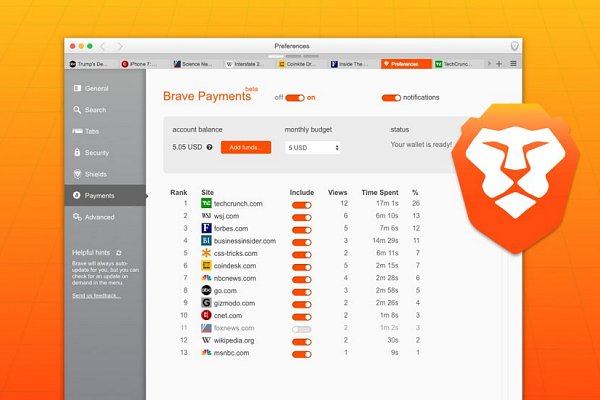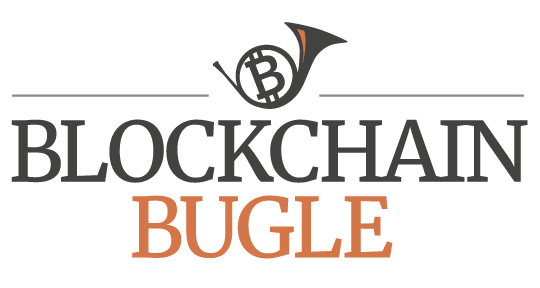Brave to Integrate Bitcoin Micropayments: For "Users Who Will Take a Stand and Fight Back"

In March, Bitcoin Magazine covered the launch of the Brave browser, which offers faster browsing by replacing ads with clean and light ads. The announcement stated that the forthcoming version of the Brave browser, planned for April, would include micropayments and a built-in Bitcoin wallet. It has taken a bit longer, as it usually happens in innovative tech, but Brave micropayments and Bitcoin support are finally here.
Brave announced the beta version of Brave Payments, a Bitcoin-based micropayments system that can automatically and privately pay the favorite websites of Brave users, integrated in the recent 0.11.6 release of Brave for desktop.
“For the first time in the history of web browsers, people can now seamlessly reward the sites whose content they value and wish to support, while remaining untracked by anyone, including us at Brave Software, Inc,,” said Brave founder Brendan Eich. “This removes the need for intermediaries who may overwhelm web pages with invasive trackers and ads (and sometimes even malware).”
Eich, who is also the creator of the Javascript programming language and the former CEO of Mozilla, added that users are tired of the current ad-tech ecosystem that clogs their web pages and data connections with annoying ads and tracking pixels and scripts. “[They] would be happy to go ad-free if they could instead funnel their support directly to the websites they visit,” said Eich. “Brave Payments now makes it possible for such users to try sending small payments to sites, at whatever aggregate support level they choose.”
The core defining feature of the Brave browser, replacing annoying resource-hungry and privacy-unfriendly ads with clean and light ads, is that it is now and will remain free. “Brave is a browser that blocks ads by default and it will always be free,” states the Brave Payment FAQ. “If you can afford to support your top sites, we encourage you to try Brave Payments, but you do not have to pay to use Brave.”
Brave partnered with BitGo to build custom wallets for Brave users. As soon as a user enables Brave Payment, a wallet is created automatically by the system. The wallet, which is tied to the computer (integration between different wallets belonging to the same user is forthcoming), can be funded with monthly contributions (minimum $5 per month) from an external Bitcoin wallet. The company has partnered with Coinbase to allow users without an existing Bitcoin wallet to fund their Brave wallet with a credit or debit card via Coinbase. Brave has also partnered with Private Internet Access, to mask the users’ IP addresses.
The monthly contributions of Brave users are split among the sites visited by contributors, based on a combination of visits and time spent on each site. The analysis is done without revealing user identities via the Anonize protocol over the network and via statistical voting on devices. The site publishers can collect their payments by verifying their ownership of the site with a procedure similar to that used to veryfy the ownership of a domain.
“Standardizing anonymous micropayments will take years of effort before something cross-browser can be added to the Web’s specifications,” said Eich, adding that he hopes to build “a truly private (even decentralized) eventual standard for web payments.”
Bitcoin Magazine reached out to Eich to find out more. Please read also our previous interview, where Eich elaborated on Brave’s business model and overall philosophy, influenced by legendary internet pioneers like Ted Nelson and Jaron Lanier.
“We definitely want to standardize anonymous micropayments for the Web, for example,” Eich told Bitcoin Magazine. “Also anonymous ads of a better kind, if possible. But it’s a fatal mistake to standardize prematurely, so we need users first to have leverage with competitors in standards bodies. The biggest browsers are owned by advertising and platform companies who ‘own the user’ from device purchase onward, so they face strong incentives against building and standardizing what we’re developing. Nevertheless, we hope as we grow to partner with other browsers who share our user-first and user-data-only-on-device principles. We can already see some kindred few in the field.”
As Eich notes,becoming one of the top browsers will be a very difficult task. Eich is unable to share data on the growth of Brave’s user base at this moment. “We are growing but not publishing our numbers yet and not advertising or growth-hacking until 1.0 when we can retain users who expect a full feature set, especially in comparison to other top browsers,” he said. “We’ll publish in due course. Things are growing well and we benefit greatly from publicity around our innovations as we release them.”
The Brave Payment announcement and FAQ have extensive information for publishers, which Eich summarizes as follows. “We are launching the beta with domain-owning publishers as first model,” Eich told Bitcoin Magazine. “We will grow to pay users who are tenants of the big ‘platform’ landlords (YouTube, Facebook, etc.) in subsequent releases. This requires paying a URL owner in full, not just a domain name owner, as the tenants do not each own a domain name.”
“We use a challenge-response protocol inspired by ACME (letsencrypt and other CAs use this) to verify domain ownership, but for path (user account on YouTube, e.g.) ownership we’ll need to do more. We are inspired by tiptheweb.org and other past attempts to pay URL owners (not just domain owners), and I wanted to tip my hat to tiptheweb.org in particular.”
“After verification, content creators come and get their bitcoin and we can develop an ongoing business relationship as is appropriate. For small publishers and eventually account-holder ‘tenants’ on the platforms, everyone may be fine using BTC and keeping things simple. For big publishers we will have more to offer down the road, in the way of safe/anonymous indirect ads, and ways to confirm direct-sold ads without tracking or any loss of privacy.”
The Brave approach could seem too involved when one thinks that users could pay their favorite websites directly, but persuading readers to pay for content and subscribe to their favorite online magazines is proving difficult.
“That’s being tried, constantly, and conversion through paywalls is pretty low, I hear less than 5 percent,” said Eich. “Users do not want to sign up at hundreds of sites and give out credit card or other payment information. It’s not happening. Blendle came to the US this year but as far as we can tell, growth is poor and most users are still in the Netherlands. This is just one example.”
Brave’s business model is centered on building its own ad network to replace the expensive, slow, resource-consuming and privacy-unfriendly ads of the main ad networks. However, that’s not happening yet.
“We are not doing Brave Ads yet and we are not planning to do them for mobile as display ads, either,” explained Eich. “This is all down the road a few months in terms of trial programs, as we bring big publisher partners on board for trials. Nothing we released today has Brave Ads elements in it.”
Eich’s first blog post is still a good summary of Brave’s long term vision and roadmap. “The details have evolved but the main principles are user-first (meaning we serve users — not advertisers, search engines, operating system or other software vendors or device makers) and user-data-defended-on-device (we don’t track and we blind ourselves to user data and identity by default),” noted Eich. “To make this a viable business built on those principles, we align our interests with our users, by sharing revenue at par (e.g. 15 percent of gross ad revenue to each of us and our user), and by vigilantly blocking and compensating for bad ads and other abusive web content.”
This is why I picked the name ‘Brave’.
“We need users who will take a stand and fight back,” concluded Eich. “We’re not just looking to get along with everyone in the existing ecosystem that evolved on the Web. In particular, we see third-party ads and tracking as toxic, and we block by default. But we’ll fight for the users wherever their interests markedly diverge from those holding the network power-centers on the Web.”
The post Brave to Integrate Bitcoin Micropayments: For ”Users Who Will Take a Stand and Fight Back” appeared first on Bitcoin Magazine.


